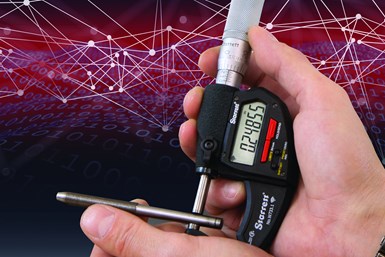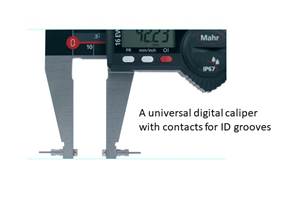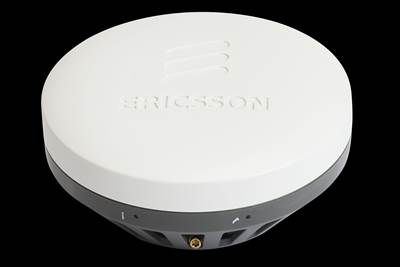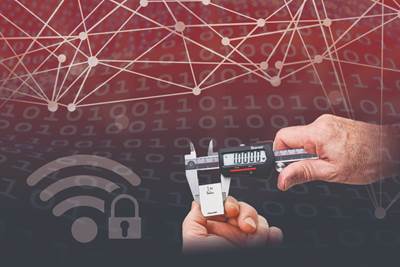Is Wireless Data Collection a Cultural Choice?
Untethered digital inspection tools are easier to justify for those who are willing to hold themselves accountable and improve for improvement’s sake.
Share






Photo Credit: The L.S. Starrett Company
Although most CNC machine shop personnel have wireless computers in their pockets, analog inspection tools paired with keyboard or pen-and-paper data recording remains the measuring method of choice for many. At what point will these dated methods be viewed not as a necessary evil, but as an unnecessary choice — perhaps even as a red flag for potentially archaic manufacturing processes and a potentially unreliable manufacturing partner?
This question came to mind when Jeff Wilkinson, director of research and development at The L.S. Starrett Company, told me that manual processes are involved in approximately 80 percent of measuring applications. However, the technology has come far enough that it doesn’t have to be this way. “The most challenging aspect of making the move is, remarkably, people,” he says. “People in management might not see the importance or need. Production supervisors and operators don’t always prioritize accountability, nor seek to add another thing to do while meeting production targets.”
Such attitudes persist even as technological barriers continue to break down. For example, DataSure 4.0, the latest version of the company’s wireless measurement software, is both faster (50 ms transmission speed) and easier to implement and expand than past-generation systems, Wilkinson says. Measurement results transmit as far as 30 feet from the gauge with a mobile phone app, or, if necessary, with one or more “gateways” that each provide a hub for as many as 20 different tools. Expanding the system is a matter of adding more gateways, as well as backpacks for personnel that extend the 30-foot range to farther than 200 feet. As for security, Wilkinson says “military-level” multi-layered data encryption prevents bad actors from “spoofing” valid credentials and using the measuring-data network to access more sensitive systems.
New levels of speed and security are possible thanks to developments in the technology underlying all wireless networks, Wilkinson says (specifically, protocols associated with the Industrial, Scientific and Medical (ISM) frequency band employed by Wi-Fi, Bluetooth and other communications). However, taking advantage of this newly available capability is a deliberate choice on the part of software developers. In L.S. Starrett’s case, incorporating high-level encryption as a standard feature of DataSure required “very high-skill-level engineering,” he says. “This is not something to approach trivially.”
No such effort is required on the part of the user, but they have choices as well. Their choices are mostly simpler, involving required distances; quality program goals (is full statistical process control (SPC) required, or more basic traceability?); and, of course, choices about the tools themselves (tools that capture a singular measurement when the operator pushes a button “are ideally suited for this system,” Wilkinson says, while those that stream measurements require “a little more setup”). The exception — the more difficult choices — are likely to be cultural in nature.
Manufacturers that lack what Wilkinson calls “a culture of accountability” are particularly likely to resist change, because accountability is inherent to wireless data collection. With no risk of clerical errors or misreading gages, results transmitted directly from hand-tool to computer are never in dispute. Taking manual data entry and operator subjectivity out of the process also can eliminate problems with values changing when the gage/tool is released, mistakes being noted but not corrected, and confusion resulting from alternating between measuring and recording.
In fact, ROI is such a simple calculation in most cases that there are few excuses other than intangibles, even for manufacturers collecting results in a generic spreadsheet. For example, in one test conducted by Starrett, automatic transmission from gage to software required only 6.6 seconds per part for three simple measurements on a batch of 500, compared to 28.9 seconds for measuring, writing down and keying in results and 15.3 seconds for keying in results immediately after measuring.
The value a shop places on its data is a good indicator of whether that shop is ready, Wilkinson says. Do people view data collection and reporting as a means of satisfying the requirements of the work, or a means of improving their own process?
“We very often hear from our customers that data collection is viewed as necessary,” he explains. “While some of a manufacturers’ end customers don’t require the data itself, the manufacturer doesn’t always consider that data helps produce better product and faster decision making for in-line production. Better quality — consistent quality — is what all of our customers expect. Data collection and decision making based on that data can get you there.”
Related Content
Help Operators Understand Sizing Adjustments
Even when CNCs are equipped with automatic post-process gaging systems, there are always a few important adjustments that must be done manually. Don’t take operators understanding these adjustments for granted.
Read MoreChoosing the Correct Gage Type for Groove Inspection
Grooves play a critical functional role for seal rings and retainer rings, so good gaging practices are a must.
Read MoreThe Link Between CNC Process Control and Powertrain Warranties
Ever since inventing the touch-trigger probe in 1972, Sir David McMurtry and his company Renishaw have been focused on achieving process control over its own manufacturing operations. That journey has had sweeping consequences for manufacturing at large.
Read More6 Machine Shop Essentials to Stay Competitive
If you want to streamline production and be competitive in the industry, you will need far more than a standard three-axis CNC mill or two-axis CNC lathe and a few measuring tools.
Read MoreRead Next
Wires Make the World Wireless
Leveraging 5G requires infrastructure grounded in physical wiring and thinking grounded in practical application.
Read MoreStarrett's Datasure 4.0 Streamlines Data Acquisition
The L.S. Starrett Company has introduced its Datasure 4.0 system, which uses new wireless technology to provide swift, secure transfer of measurement data.
Read MoreProbing Feedback Keeps CNC Machining On Track
CNC machine tools that operate like self-contained, automated smart factories can be an introduction or an addition to digital manufacturing workflows.
Read More






























